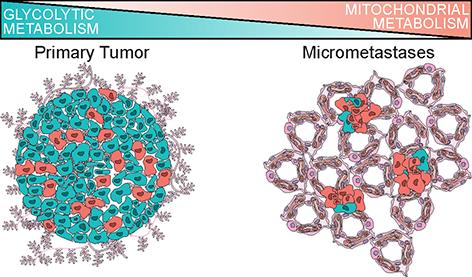Study reveals breast cancer cells shift their metabolic strategy to metastasize

By carrying out scRNAseq in patient-derived models of breast cancer, a UCI-led research team has identified metabolic adaptations that cancer cells acquire as they spread throughout the body. Above is an artistic rendering of the altered metabolism in micrometastatic cells in the lungs compared to primary tumors, opening a new potential avenue to target cancer cell spread in patients. Credit: UCI School of Medicine
New discovery in breast cancer could lead to better strategies for preventing the spread of cancer cells to other organs in the body, effectively reducing mortality in breast cancer patients.
According to a study, published today in Nature Cell Biology, breast cancer cells shift their metabolic strategy in order to metastasize. Instead of cycling sugar (glucose) for energy, they preferentially use mitochondrial metabolism.
“This has important potential clinical implications because it suggests that drugs targeting mitochondrial metabolism may have efficacy for preventing metastatic spread in patients,” said Devon A. Lawson, PhD, assistant professor in the UCI Department of Physiology and Biophysics and a member of the Chao Family Comprehensive Cancer Center at the UCI School of Medicine.
“Historically, tumors were thought to contain dysfunctional mitochondria and be principally sustained by anaerobic glycolysis, or Warburg metabolism. Our work challenges that dogma and shows that breast cancer cells use mitochondrial metabolism during metastatic spread.”
Despite major advances in the detection and treatment of early stage disease, metastasis – when cancer cells in the breast spread to other organs in the body – accounts for approximately 40,000 deaths among women in the U.S. each year. It is the number one cause of nearly all mortality associated with breast cancer.
Previous work suggests that metastasis is seeded by rare primary tumor cells with unique biological properties that enable them to spread, causing the cancer to take hold in other locations in the body.
While properties promoting cell motility and migration are well studied, mechanisms governing the seeding and establishment of small collections of cancer cells in distal tissues are not.
This is in part because metastatic seeding cannot be studied in humans, and because it is technically challenging to detect and analyze rare cells at this transient stage in animal models.
“Through our research, we established a robust new method for identifying global transcriptomic changes in rare metastatic cells during seeding using single-cell RNA-sequencing and patient-derived xenograft (PDX) models of breast cancer,” said Ryan Davis, first author on the study and a doctoral student in the Lawson laboratory.
“We found that metastatic cells harbor distinct RNA molecules that are highly predictive of poor survival in patients and alter metabolism in a way that can be targeted therapeutically.”
###
This research was funded by a Cancer Center Support Grant, a Center for Complex Biological Systems Support Grant, as well as through support from the National Cancer Institute, National Institutes of Health, the National Science Foundation, the Team Michelle and Friends non-profit organization, the Suzette Kirby Breast Cancer Research Fund, and the V foundation.
About the UCI School of Medicine
Each year, the UCI School of Medicine educates more than 400 medical students, and nearly 150 doctoral and master's students. More than 700 residents and fellows are trained at UCI Medical Center and affiliated institutions. The School of Medicine offers an MD; a dual MD/PhD medical scientist training program; and PhDs and master's degrees in anatomy and neurobiology, biomedical sciences, genetic counseling, epidemiology, environmental health sciences, pathology, pharmacology, physiology and biophysics, and translational sciences.
Medical students also may pursue an MD/MBA, an MD/master's in public health, or an MD/master's degree through one of three mission-based programs: the Health Education to Advance Leaders in Integrative Medicine (HEAL-IM), the Leadership Education to Advance Diversity-African, Black and Caribbean (LEAD-ABC), and the Program in Medical Education for the Latino Community (PRIME-LC). The UCI School of Medicine is accredited by the Liaison Committee on Medical Accreditation and ranks among the top 50 nationwide for research. For more information, visit som.uci.edu.
Media Contact
All latest news from the category: Life Sciences and Chemistry
Articles and reports from the Life Sciences and chemistry area deal with applied and basic research into modern biology, chemistry and human medicine.
Valuable information can be found on a range of life sciences fields including bacteriology, biochemistry, bionics, bioinformatics, biophysics, biotechnology, genetics, geobotany, human biology, marine biology, microbiology, molecular biology, cellular biology, zoology, bioinorganic chemistry, microchemistry and environmental chemistry.
Newest articles

First-of-its-kind study uses remote sensing to monitor plastic debris in rivers and lakes
Remote sensing creates a cost-effective solution to monitoring plastic pollution. A first-of-its-kind study from researchers at the University of Minnesota Twin Cities shows how remote sensing can help monitor and…

Laser-based artificial neuron mimics nerve cell functions at lightning speed
With a processing speed a billion times faster than nature, chip-based laser neuron could help advance AI tasks such as pattern recognition and sequence prediction. Researchers have developed a laser-based…

Optimising the processing of plastic waste
Just one look in the yellow bin reveals a colourful jumble of different types of plastic. However, the purer and more uniform plastic waste is, the easier it is to…



